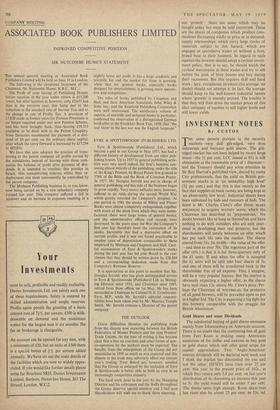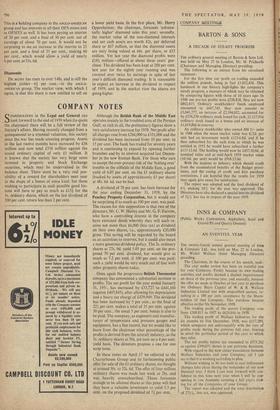INVESTMENT NOTES
By CUSTOS
"TIHE same pattern prevails in the security I markets—very dull gilt-edged, very firm industrials and buoyant gold shares. The gilt- edged market has not been helped by recent large issues—the 51- per cent. LCC issued at 951 is still obtainable at the reasonable price of I discount— and the Treasury should pay some attention to Sir Roy Harrod's published view, shared by many City professionals, that the yield on British gov- ernment stock § is at 'an unhealthy high level' (51 per cent.) and that this is due mainly to the fact that supplies of bank money arc being kept at 'an abnormally low level.' Industrial shares have been enlivened by bids and rumours of bids. The latest is Mr. Charles Clore's offer (from SEARS HOLDINGS) IO acquire WATNEY MANN, which the Chairman has described as 'preposterous.' No doubt brewers like to keep to themselves and have nothing to do with outsiders who are only inter- ested in developing their real property, but the shareholders will surely welcome an offer which has put such life into the market. The shares soared from 51s. 3d. to 60s.—the value of the offer —and then to over 70s. The ingenious part of the offer (45s.) is that it is for three-quarters only of the £1 units. If and when the offer is accepted the £1 units will be split into four shares of 5s. and one of them will be transferred back to the shareholder free of all expense. This, I imagine, will be a very popular feature. But the market is obviously expecting a higher offer, as the shares have now risen 12s. above Mr. Clore's price. Per- haps the Chairman of WHITBREAD, the protector of all good brewers, will be prevailed upon to put in a higher bid. The City is expecting a big fight for this brewery comparable with the struggle for British Aluminium.
Gold Shares and some Dividends
The substantial buying of gold shares emanates mainly from Johannesburg on American account. There is no doubt that the continuing loss of gold from Fort Knox is making many Americans suspicious of the dollar and anxious to buy gold or gold shares which still offer good scope for capital appreciation. Two- 'Anglo-American' interim dividends will be declared next week and I think the market has discounted the one and not the other. OFSITS have risen over 25 per cent, this year to the present price of 102s., at which they return only 3.8 per cent. on last year's distribution of 4s. Assuming an increase this year to 5s. the yield would still be under 5 per cetit. The shares seem high enough. RAND SELECTION has risen also by about 25 per cent. to 53s. 6d. This is a holding company in the ANGLO-AMERICAN group and has interests in all their OFS mines and in OFSITS as well. It has been paying an interim of 20 per cent. and a final of 30 per cent, out of earnings of about 70 per cent. It would not be surprising to see.an increase in the interim to 25 per cent, and a final of 35 per cent., making 60 per cent., which would allow a yield of nearly 6 per cent. at 53s. 6d.
Diamonds
DE BEERS has risen to over 148s. and is still the highest yielder-61 per cent.—in the ANGLO- AMERICAN group. The market view, with Which I agree, is that this share is now entitled to sell on a lower yield basis. In the first place, Mr. Harry Oppenheimer, the chairman, forecasts 'substan- tially higher' diamond sales this year; secondly, the market value of the non-diamond interests and net cash assets are worth 82s. per deferred share or £67 million, so that the diamond assets are only being valued at 66s. per share, or £53 million. Yet last year the diamond profits were £18+ million—offered at about three years' pur- chase. The dividend has been kept at 200 per cent. last year for the eighth year running and was covered over twice by earnings in spite of last year's difficult diamond trading. It is reasonable to expect an increase in the dividend in respect of 1959, and in the market view the shares are going higher.















































 Previous page
Previous page